How to tell cilantro from parsley
On store shelves, you can find two similar bundles of greens: parsley and cilantro (aka coriander). It is easy to confuse them at a cursory examination, and this can lead to incidents when preparing dishes or traditional medicine.
Such a mistake can be potentially dangerous to health, since the effect on the body of these herbs is different. In this article, we will tell you how to distinguish parsley from cilantro and what is the composition of these similar-looking plants.
The content of the article
Description of parsley and coriander
The aromatic parsley and tart coriander, which can be found on store shelves in winter and in vegetable garden beds in summer, have different chemical compositions and origins. To understand how one plant differs from another, consider their characteristics.
Characteristics of parsley
Curly parsley (Petroselinum crispum) is a herbaceous plant native to the rocky soils of southern Greece. The very name "petroselinum" translated from Greek means "growing on a stone."
Botanical characteristics: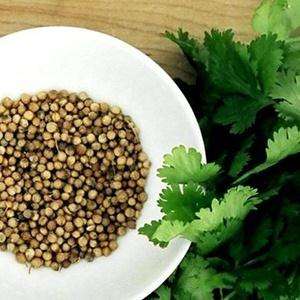
- family Umbrella, class Dicotyledonous;
- growing season 2 years;
- plant height 30-100 cm;
- pivotal root system, root with fusiform thickening;
- the stem is erect;
- leaves are double pinnately dissected, triangular, dark green with a shiny surface;
- flowers are greenish-yellow, collected in inflorescences complex umbrellas on the tops of the stems;
- fruits are oblong-ovate;
- flowering period - from June to July, fruiting period - in August.
The shoots of the first year of the growing season give a greater yield of greenery, the shoots of the second year are more fertile in terms of seeds.
Seed chemical composition:
- essential oils (up to 7%) containing apiol, furocoumarin, bergapten and apiin;
- nutrients - fats (up to 22%), proteins, carbohydrates;
- vitamins A, E, C, groups B and H;
- mineral components - potassium, calcium, magnesium, sodium, phosphorus and iron.
Parsley seeds are used to obtain essential oil, as well as raw material for the production of technical oil, in cooking - as a seasoning for baking bread. In medicine, shoots and seeds are used as components of diuretic charges, from which a number of drugs are obtained, used for flatulence, neuralgia and dysmenorrhea.
The chemical composition of fresh herbs:
- nutrients - proteins, fats, carbohydrates;
- vitamins - A, E, K, C, H, group B;
- essential oil (up to 0.3%);
- biologically active substances - flavonoids and phytoncides;
- minerals - potassium, calcium, iron, magnesium, phosphorus, sodium, zinc, copper, manganese and selenium.
Fresh and dried greens are used in cooking as a seasoning for meat, fish dishes, soups and salads. Umbrellas and dried leaves are added to canned meals.
Juice is obtained from fresh shoots, which is used in folk medicine as a prophylactic agent that improves the functions of the adrenal cortex and thyroid gland. In traditional medicine, dietary supplements and drugs with a diuretic effect are made from parsley.
Parsley preparations support the tone of the smooth muscles of the uterus, intestines and bladder.
Medicines and meals with parsley are contraindicated in pregnancy due to the increased risk of uterine bleeding during placental abruption and uterine contraction, which can seriously harm the body and lead to miscarriage.
It is interesting:
Distinguishing pungent fruits is easy and simple - cayenne pepper and chili.
Characteristics of coriander
Sowing coriander (Coriandrum sativum) is a herbaceous plant native to Ancient Rome. The name of the plant comes from the Mycenaean Greek "κoρις", meaning the word "bug", since immature leaves have a specific smell, similar to that emitted by bedbugs in danger.
Cilantro is a coriander green that is harvested before the seeds are ripe. The word "cilantro" comes from the Georgian language, this seasoning is widely used in Georgian national dishes.
Botanical characteristics: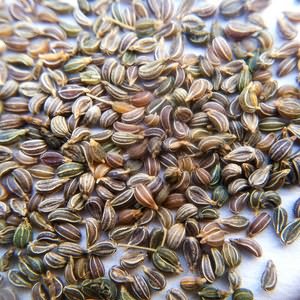
- family Umbrella, class Dicotyledonous;
- growing season 1 year;
- plant height 40-70 cm;
- tap root, fusiform;
- stem glabrous, straight, with branching in the upper part;
- the shape of the leaves changes depending on the position on the stem - the basal leaves have a broad-bladed, tripartite, coarsely dissected leaf plate, in the lower part of the stem, leaves with a short petiole are twice pinnately divided, in the middle and upper part of the stem, leaves are sessile pinnately dissected with linear lobes;
- flowers are white or pink, collected in an inflorescence with a complex umbrella at the tops of peduncles;
- fruits - non-decaying droplets of ovoid-spherical shape;
- flowering period - from June to late July, ripening period - from August to September.
Coriander is cultivated everywhere, including in the central regions of Yakutia. Distributed not only in the temperate and subtropical climatic zone of Eurasia, but also in America, Australia and New Zealand.
Seed chemical composition:
- essential oil (up to 1.6%) containing linalool, geraniol, borneol, geranyl acetate and other volatile components;
- nutrients - proteins, fats (up to 28%), carbohydrates;
- vitamins B1, B2, C, PP;
- mineral components - calcium, magnesium, phosphorus, sodium, potassium, iron, manganese, copper, selenium, zinc;
- biologically active substances - sterols, tannins, organic acids, rutin.
The fruits are used in cooking as a seasoning for meat, fish dishes, Borodino bread, canned products. In medicine, seeds are used to obtain drugs that have choleretic, expectorant, carminative, antihemorrhoidal, laxative, appetite-stimulating and wound-healing properties.
Essential oil from coriander seeds is used in perfumery and in the manufacture of cosmetics. Fatty oil is used in soap making.
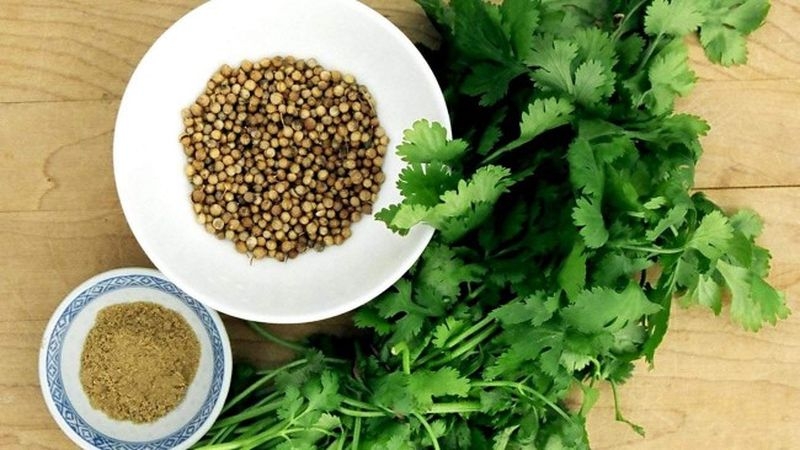
Chemical composition of cilantro:
- nutrients;
- vitamin A, groups B, C, E, K, PP;
- aldehyde trans-tricedenol-2, which gives the plant an unpleasant "bug" odor;
- biologically active substances - choline, carotenes, rutin;
- minerals - calcium, iron, magnesium, phosphorus, potassium, sodium, zinc, copper, manganese, selenium.
Greens are used as a seasoning for meat dishes, soups and salads. Young leaves are eaten, before the formation of the arrow of the stem. In folk medicine, cilantro juice and decoction are used to improve vision, with nervous disorders, indigestion and with high cholesterol levels.
Comparative characteristics of parsley and coriander
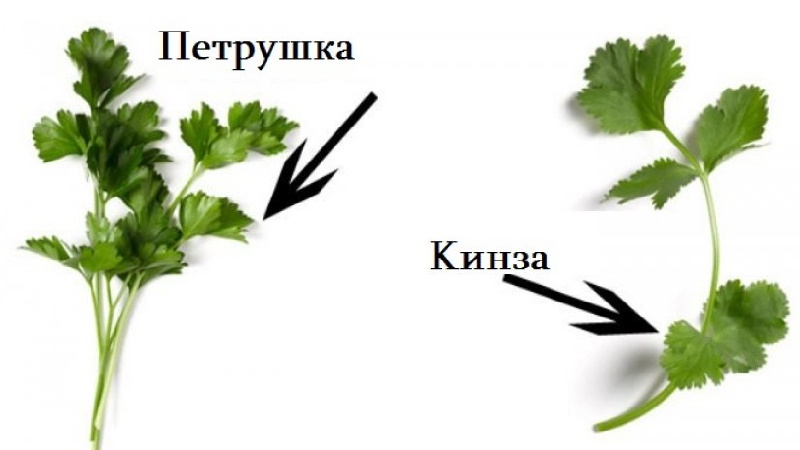
Plants belong to the same Umbellate family, but to different genera. The differences between cilantro and parsley are shown in the table.
| Distinctive feature | Parsley | Cilantro |
| Leaf shape | Double pinnately dissected | Tripartite coarsely dissected and doubly pinnately divided |
| Smell | Pleasant, spicy | Unpleasant, sharp "bug" |
| Application during pregnancy | Prohibited | Allowed in limited quantities |
| Daily intake | 50 g, exceeding the norm can lead to poisoning, hallucinations and seizures | 105 g, exceeding the norm leads to sleep disturbance, weakening of memory, hormonal disruptions in women |
| Vitamin content (except for A, B, E, K and C, which are found in both plants) | Contains biotin - vitamin H | Contains niacin - vitamin PP, choline - B4 |
| Flower color | Greenish yellow | White or pink |
| Stem height | Up to 100 cm | Up to 70 cm |
| Plant life | 2 years | 1 year |
In the photo, you can see the difference in the appearance of these two herbaceous plants, but the most telling sign by which you can distinguish coriander and parsley greens is the smell. If a bunch of greens has a specific smell of bedbugs, you are holding cilantro in your hands, not parsley.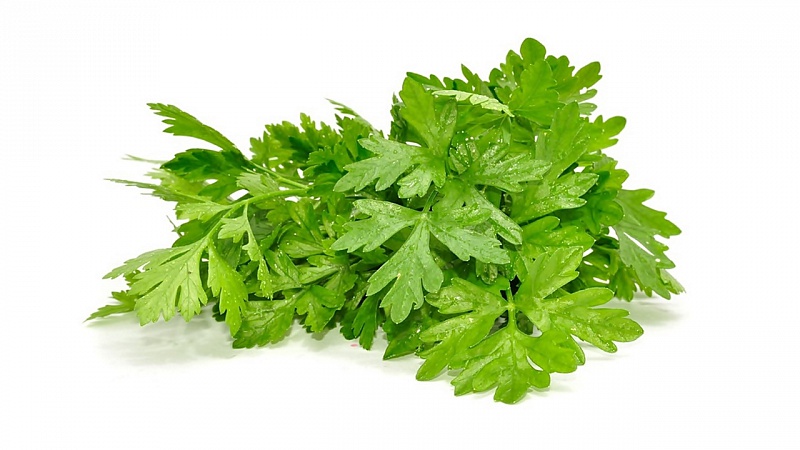
The seeds of these plants are even easier to distinguish. In coriander, they are in the form of small yellow-brown round peas, and in parsley, they are pear-shaped with easily separating slices.
Read also:
How to make ice from parsley for the face: beauty and health of the skin.
Conclusion
Coriander and parsley are not the same, but completely different plants. You can distinguish the greens of these plants by smell and appearance. These species have a different chemical composition, therefore, their areas of application are different.
Cilantro greens are not used in traditional medicine, however, folk recipes with this plant are known. Parsley is used in traditional medicine as a raw material for the production of drugs and medicinal preparations. Both plants are used in the culinary and cosmetic industries.